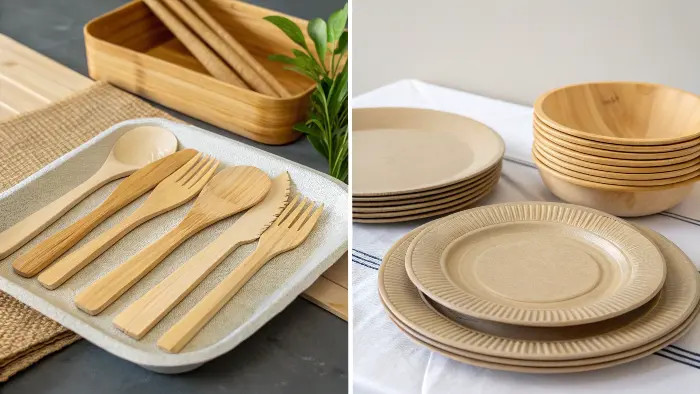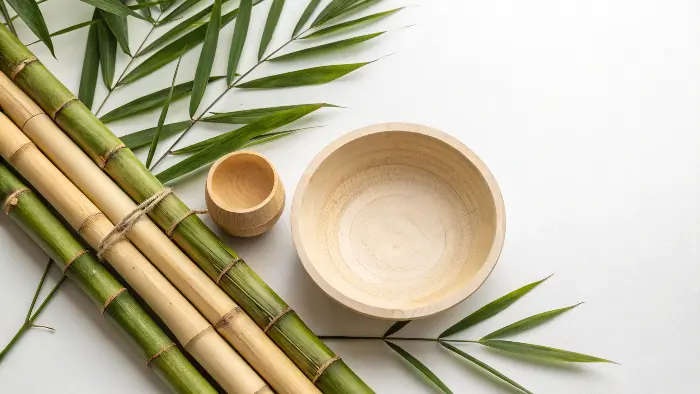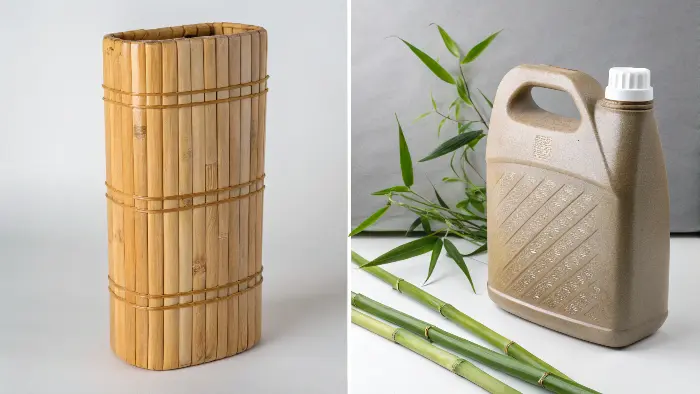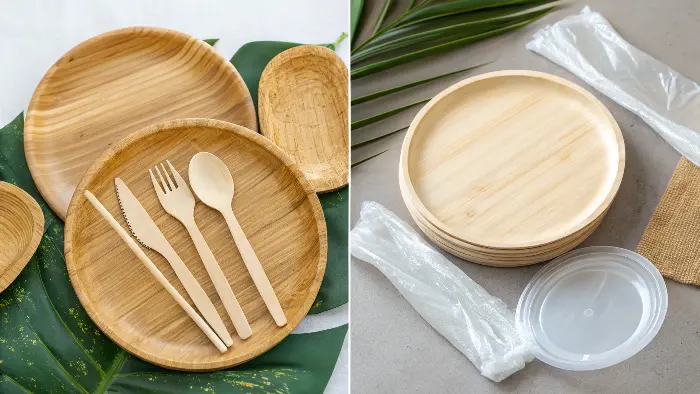You’re trying to choose the best tableware for your brand, but the safety information is a minefield. On one hand, plastic has known risks like BPA. On the other, you hear alarming reports about chemicals in bamboo composites. This confusion makes choosing a genuinely safe product feel like a gamble.
Neither material is automatically safe; it depends on quality and proper use. Many plastics can leach endocrine disruptors like BPA, while low-quality reusable bamboo tableware can leach formaldehyde. However, a high-quality, certified bamboo product, used correctly (no microwaving), is generally safer as it avoids the risks of BPA, phthalates, and microplastics inherent in many conventional plastic items.

Making the right choice isn’t about picking a material, it’s about understanding the science behind it. The safety of your customers and the integrity of your brand depend on looking past the marketing claims and focusing on the certifications and manufacturing processes. Let’s dig into the details so you can source with total confidence.
Is bamboo a food safe material?
When you see "bamboo," you think natural, pure, and safe. But then you read about binders and resins, and suddenly that clean image gets complicated. This doubt can stop you from embracing what should be a fantastic eco-friendly option, fearing you might be misled.
Yes, raw bamboo itself is an inherently food-safe material. It’s a natural grass with no toxins. The safety questions arise with reusable bamboo products, which are composites made from bamboo fiber and a binder, usually melamine. The safety of these products depends entirely on using a high-quality, food-grade binder and verifying it with certifications like LFGB or FDA.

I’ve walked through countless factories, and the journey from a bamboo stalk to a dinner plate is fascinating. The raw material is perfect. The crucial part of the safety conversation starts when that natural fiber is mixed with something else to make it durable and reusable. This is where a buyer’s expertise is truly tested.
Two Worlds of Bamboo Tableware
To talk about safety, we must first separate bamboo tableware into two distinct categories.
- 100% Natural Bamboo (Disposable): These products, often plates or cutlery, are made by simply cleaning, steaming, and pressing layers of bamboo sheath. No glues, no binders, no chemicals. They are as safe as the plant they came from and are fully compostable.
- Bamboo Fiber Composites (Reusable): These are the durable, colorful plates and cups sold for everyday use. They are made by mixing fine bamboo powder with a binding agent—most commonly melamine resin—to create a strong, dishwasher-safe material.
The safety concerns are almost exclusively focused on the second category. For a professional buyer like Jacky in Canada, this distinction is critical. He needs to know if the product’s end-of-life is a compost bin or if its value lies in years of reuse.
Here’s a clear breakdown:
| Feature | 100% Natural Bamboo (Disposable) | Bamboo Fiber Composite (Reusable) |
|---|---|---|
| Composition | Pure bamboo sheath | Bamboo powder + Melamine binder |
| Safety Profile | Inherently safe, non-toxic | Depends on binder quality & certs |
| Primary Risk | Minimal; basic food hygiene | Leaching from low-quality binder |
| Certification | BPI for compostability | LFGB/FDA for food contact safety |
So, while the bamboo itself is perfectly safe, the real safety investigation for reusable products is all about the quality of the materials it’s combined with.
Is bamboo less toxic than plastic?
You’re ready to move away from plastic, but you need to be sure you’re not just trading one problem for another. The fear is that you’ll ditch BPA only to end up with formaldehyde, leaving your customers no better off. Let’s put them head-to-head.
Yes, a high-quality, certified bamboo composite product is generally less toxic than many common plastics. While its primary risk is the potential leaching of melamine or formaldehyde if made poorly or microwaved, many plastics carry risks from known endocrine disruptors like BPA and phthalates, as well as the shedding of microplastics.

This is a conversation I have with clients every week. It’s not about finding a "perfect" material with zero risks, but about choosing the material with the lowest, most manageable risk profile. When you compare the science, certified bamboo comes out ahead.
The Known Risks of Plastic
For decades, plastic has been the default, but we now know it comes with significant health concerns.
- BPA (Bisphenol-A): Found in hard, clear polycarbonate plastics. It’s a well-known endocrine disruptor, meaning it can interfere with the body’s hormones. It leaches when heated, scratched, or exposed to acidic foods.
- Phthalates: These chemicals are used to make plastics like PVC soft and flexible. They are also endocrine disruptors and can leach out of the material over time.
- Microplastics: This is a huge concern. All plastic products shed microscopic particles throughout their lifespan. We ingest these particles, and while the full long-term health effects are still being researched, it’s a risk that doesn’t exist with natural fiber products.
The Manageable Risks of Bamboo Composites
The concerns with reusable bamboo tableware are real but specific.
- Melamine and Formaldehyde: These are the components of the resin binder. The risk is that tiny amounts can migrate from the plate into food. However, this migration is a significant problem primarily under two conditions: 1) when a cheap, industrial-grade resin is used, or 2) when the plate is exposed to very high heat, like in a microwave.
This is why a certified product is so different. Certifications like LFGB are extremely strict about migration limits, ensuring that any potential transfer is far below harmful levels. By choosing a certified product and instructing customers not to microwave it, you effectively manage and minimize the risk.
| Risk Factor | Common Plastic (e.g., Polycarbonate) | Certified Bamboo Composite |
|---|---|---|
| Primary Chemicals | BPA, Phthalates | Melamine, Formaldehyde |
| Leaching Trigger | Heat, scratches, age, acidic foods | High heat (microwave), high acid |
| Health Concern | Endocrine disruption, unknown microplastic effects | Toxicity at high levels (mitigated by certs) |
| Mitigation | Look for "BPA-Free" plastics | Demand LFGB/FDA certs, no microwave use |
| Microplastics | Yes, a significant and growing concern | No (the fiber is natural) |
When you look at the evidence, you’re trading the widespread, hard-to-control risks of plastic for the specific, manageable risks of a certified bamboo composite. For a safety-conscious brand, that’s a much better position to be in.
Are bamboo plates and utensils safer than plastic?
Theory is one thing, but you need a clear answer for your product line. When it comes down to a direct choice between a bamboo fork and a plastic one, which is the safer bet for your customers? This decision will define your brand’s commitment to health and safety.
Yes, certified bamboo plates and utensils are a safer choice than many of their plastic counterparts. They are free from the BPA, phthalates, and microplastic shedding associated with plastics. Their safety is secured by sourcing products with trusted certifications (LFGB/FDA) that guarantee the binder is stable and by ensuring they are never used in the microwave.

This is where the rubber meets the road. As a buyer, your most important job is to establish a sourcing protocol that guarantees safety. It’s not about hoping a product is safe; it’s about building a system that ensures it.
A Practical Checklist for Sourcing Safe Bamboo Tableware
When I work with partners like Jacky, we don’t just talk about materials; we build a sourcing process. This turns a complex decision into a series of simple, verifiable steps.
- Define the Product Type: First, decide if you need a single-use, 100% compostable item or a durable, reusable one. This determines the entire safety and material profile.
- Specify the Binder: For reusable products, explicitly require A5 food-grade melamine resin. This is non-negotiable. Any supplier who hesitates on this point is a red flag.
- Demand Current Certifications: This is the most critical step. Ask for a current, valid LFGB or FDA test report. The LFGB standard from Europe is often considered the most rigorous. The report must be from a reputable third-party lab like SGS, Intertek, or TÜV. Do not accept an expired report or an internal "declaration of conformity."
- Confirm It’s BPA-Free: While the main binder isn’t BPA, this confirms no other additives are used and provides an extra layer of consumer confidence.
- Provide Clear Use and Care Instructions: Your responsibility doesn’t end at the sale. You must clearly communicate to the end-user that the product is dishwasher-safe but must never be microwaved. This prevents misuse that could compromise an otherwise safe product.
By following this checklist, you are not just buying a product; you are curating a safe and reliable offering for your customers. You are moving from a position of uncertainty to one of control and confidence.
Conclusion
The choice between bamboo and plastic tableware isn’t black and white. Safety depends on quality. While many plastics pose risks from BPA and microplastics, certified bamboo composites offer a safer alternative when sourced diligently and used correctly. Your best strategy is to demand proof of safety through rigorous LFGB/FDA certifications.


